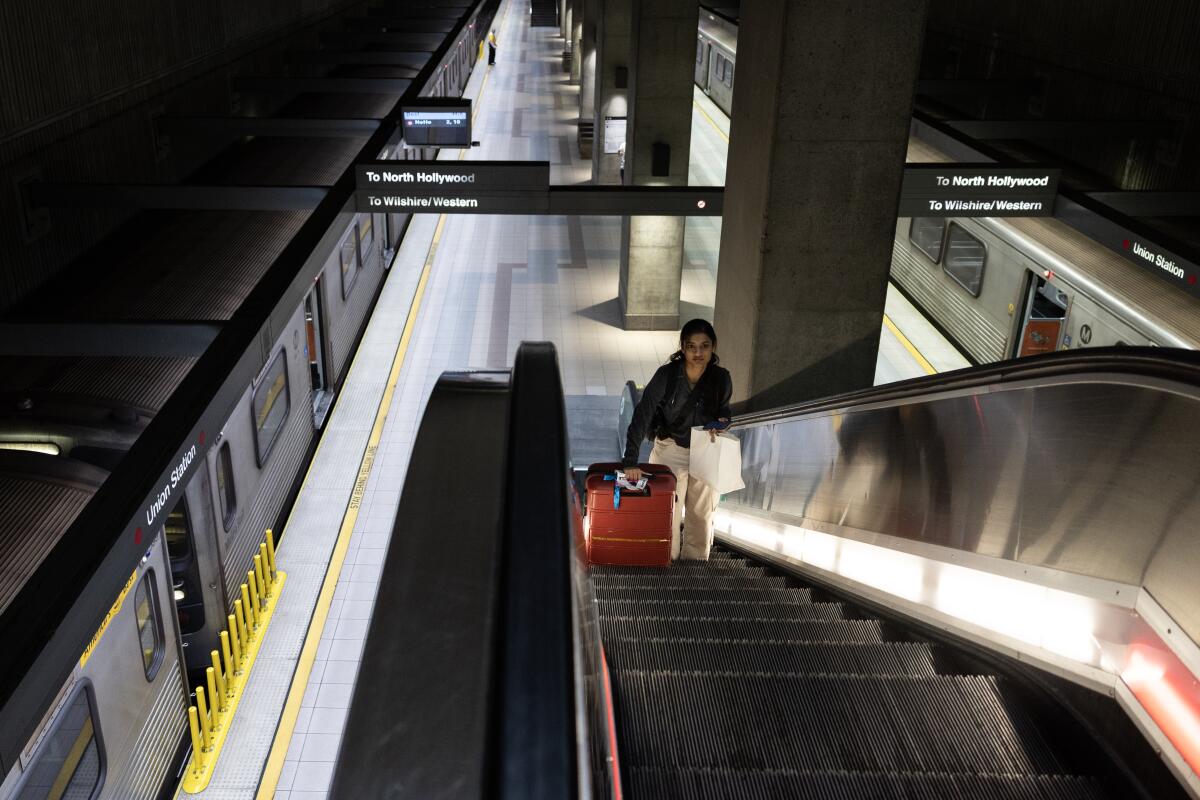
- Share via
Reports of federal agents detaining commuters sitting at a bus stop in Pasadena this week have heightened concerns about immigration officials targeting public transportation — a key aspect of city life — in their efforts to carry out deportations across Southern California.
For the thousands of Angelenos, many of whom are Latino and rely on the city’s vast network of buses and trains to go about their daily lives, the incident in Pasadena has brought a new level of fear and uncertainty for public transportation riders.
After June 6, when immigration agents launched a campaign in Los Angeles to find and capture undocumented immigrants, some residents have started to go underground, staying away from work, school, churches and other public venues for fear of being swept up in a raid.
Now, as many attempt to resume their daily routines, buses and trains have become yet another place to fear. There has been a 10% to 15% decline in bus and rail ridership since immigration enforcement activities began, according to Metro officials.
“The way that ICE is going about these sweeps is terrifying people,” Los Angeles County Supervisor Janice Hahn said in a statement on Wednesday. “This isn’t right. The fear they are spreading is doing profound harm in our communities.”

While rumors have swirled online about immigration officials’ presence at bus stops and along rail lines for weeks, the most visible example happened early Wednesday when a group of masked immigration officers approached two men sitting at a bus stop outside the Winchell’s Donut House on Los Robles Avenue in Pasadena.
After a brief conversation, an officer is seen on video handcuffing one of the men. Officials said a total of six Pasadena residents were detained.
A week of immigration sweeps across Southern California has left some communities terrified, with fewer people on the streets and signs of an economic slowdown.
The bus stop for Route 662, roughly a block away from an elementary school, is near several Latino businesses in an area of the city known for Mexican eateries. Workers in the area frequently grab coffee and breakfast at the doughnut shop before heading to work. The incident was witnessed and videotaped by several people in the area.
Another video of the incident showed a witness bending down behind an unmarked vehicle — reportedly belonging to federal agents — trying to get a photo of the license plate. The footage shows a masked man exit the driver’s side and rush toward the back of the vehicle, pointing a gun at the witness who retreated quickly to the sidewalk.
“Leave our city!” one resident screamed at the masked man. As other witnesses started to approach the vehicle with their phones out, the driver activated the car’s lights and siren and sped off.
While the early morning sweep was just one of several that immigration officials carried out in Pasadena on Wednesday, the arrests and viral video drew vocal criticism.

A man walks past a bus stop in downtown Thursday.

City Hall from the metro 70 bus downtown.
“This is lawlessness,” state Sen. Sasha Renée Pérez (D-Alhambra) said of the raid in a video statement on X. “This is completely inappropriate. This is an incredibly dangerous way to operate. Somebody is going to get seriously hurt ...”
Rep. Judy Chu (D-Monterey Park), whose district includes Pasadena, called the situation “outrageous.”
“These raids in my district are absolutely vile. Masked and armed like a militia, they’re terrorizing families and destroying any sense of safety in our communities. This is not law enforcement it’s a gross abuse of power, and I will not stand for it,” Chu wrote in a statement.
Pasadena public information officer Lisa Derderian said city officials are still trying to determine who got out of the unmarked car and pointed the gun since a search of the license plate by the city came up empty and no identification could be seen in footage.
Once-bustling immigrant hubs across L.A. have seen foot traffic drop in recent days as ICE detentions continue. The Los Angeles Archbishop said he’s been “disturbed” by the raids, which have caused panic among his majority-Latino parishioners.
The situation prompted the city to increase its law enforcement presence outside schools and around bus stops, she said.
“We have an obligation to protect our community. Obviously, we don’t want too heavy of a presence to look like we are coordinating or interfering with any federal enforcement. But again, we do have an obligation to protect,” Derderian said.
Many rail and bus riders use public transit out of necessity and may not have access to alternative transportation, said Michael Schneider of the Streets for All advocacy group.
A 2023 Metro survey showed that more than 60% of bus riders and roughly 50% of rail riders are Latinx/Hispanic. And nearly 90% of bus riders and more than 70% of rail riders’ annual household income is less than $50,000.
“For most people that ride Metro … the household income is extremely low,” Schneider said. “They are riding the bus because that is the way they get to and from work, and that’s the way they get around. They don’t have a car at home, they don’t have another option.”
Metro has been working to build back public trust and grow ridership following a spate of violence on bus and trains in recent years.
Employees and regulars at Union Station said on Thursday that they have noticed a slight downturn in foot traffic in recent weeks.
“There’s less passengers than normal,” said Johnathan Aros, a security guard at the station. “I wouldn’t say it’s significant, but it’s different.”

The steps at the bottom of Civic Center metro station are empty downtown.

A lone rider leaves the redline at Union Station.
Hahn, who also serves as the Metro board chair, asked Metro staff on Wednesday to report back to the board about the agency’s protocols if immigration agents board a bus or a train.
Earlier this year, as immigration enforcement grew across the country, Hahn directed Metro staff to partner with L.A. County’s Office of Immigration Affairs and amplify ongoing “Know Your Rights” campaigns to support immigrant riders and inform them of their protections when dealing with law enforcement.
“Now more than ever, it is essential that our public transit system serves as a safe and inclusive space for everyone,” Hahn wrote in a letter to Metro Chief Executive Stephanie Wiggins. “Sharing critical information and campaigns that educate our riders about their rights, specifically in relation to ICE and law enforcement interactions, is a powerful tool that could help alleviate the anxiety that many of our immigrant communities are experiencing.”
Immigration raids continued to ratchet up anxiety and anger over the weekend across Southern California, including at the Santa Fe Springs Swap Meet.
On Thursday morning, as the Metro bus cruised over the L.A. River toward downtown — where widespread protests and immigration raids erupted earlier this month — riders wearing various retail and food service uniforms sat silently staring straight ahead. A quiet tension on the nearly full bus was palpable.
A Boyle Heights woman riding the bus said she’s grown more weary of public transportation since the raids began, but like many others she’s left with few options to get to work.
“Some people are scared, but they have to work,” said the woman, who asked that she not be identified because she’s concerned she’ll be targeted by immigration officials. “There’s work no matter what.”
Yomara Oxlha, who works at a general store in Boyle Heights across from a bus stop, said a quiet distrust of public services had spread in the community.

“I’ve seen videos of bus drivers saying that ICE is inside [buses],” Oxlha said. “Let’s say if I’m an immigrant, and [ICE] goes inside supermarkets, they go inside the buses, the trains and they go inside stores … I wouldn’t feel comfortable going out at all.”
Oxlha said Boyle Heights has been quiet since the raids began on June 6. Now, left with few alternatives to support their families, many have started to fearfully resume their schedules.
Sophia, a Boyle’s Height resident, waited patiently on Thursday at the bus stop she has taken nearly every day for years. The woman, who declined to provide her last name out of fear she could be targeted by immigration officials, told The Times in Spanish that she’s become more acutely aware of her surroundings.
For nearly a week, Sophia hesitated to leave her home and her family has lived in a constant state of uncertainty. But now, she must finally get back to her normal schedule, she said.
“The fear of going out to look for a dream is now a nightmare,” Sophia said in Spanish. “It’s very sad this is all happening.”
Staff writer Rong-Gong Lin II contributed to this report.
More to Read
Sign up for Essential California
The most important California stories and recommendations in your inbox every morning.
You may occasionally receive promotional content from the Los Angeles Times.




















